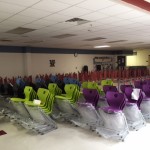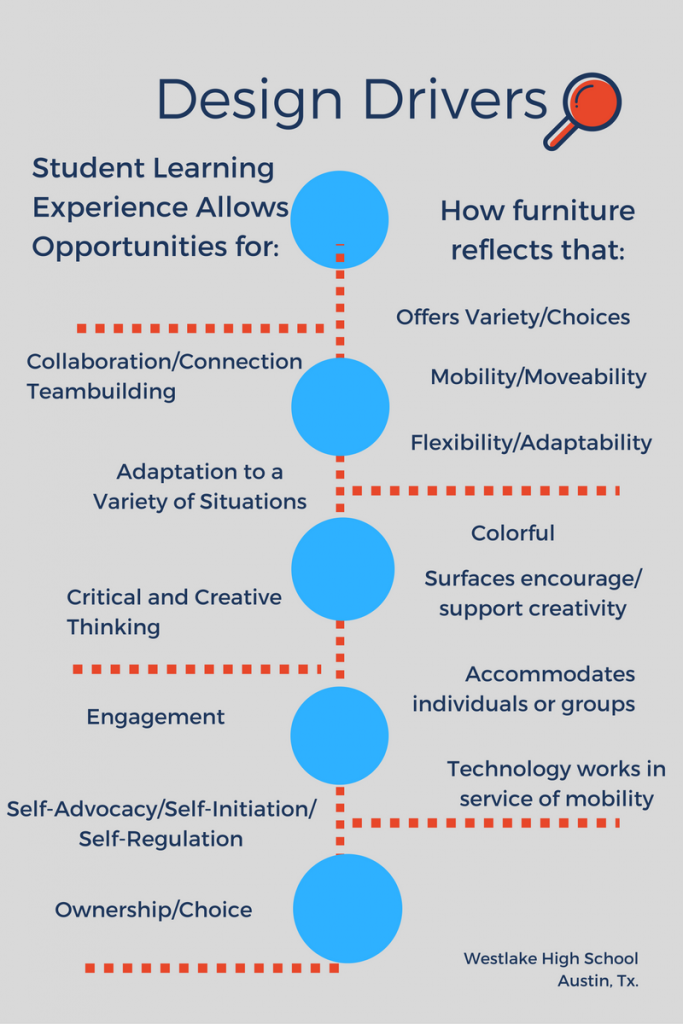As our district continues their focus on the impact of 1:1 technologies on creating more student-centered learning, we began looking at how we could start creating classrooms that resembled the teaching we wanted to happen. Too often, we are asking teachers to empower and engage students in new ways, but to teach in antiquated, uninspiring and inflexible spaces. Over the last few years, a handful of teachers have begun informally experimenting with revamping their classrooms. But for there to be real change combined with our 1:1 iPad program, we have to impact teaching and learning from the ground up, and that includes what “classroom” even looks like. Thus was born our pilot program.
Getting Started
After recent funding, our campus was charged with a more global approach to transform the traditional classrooms on the high school campus. A committee was assembled that included school leaders, new and experienced teachers, a librarian, an instructional partner, and students. The challenge in a process like this is really keeping an eye on the big picture and not focusing on just the furniture. Knowing what you want the change to accomplish can help define the ways you design learning spaces.
We also decided to conduct our changes as a pilot, and settled on 25-26 classrooms to pilot, so that if we needed to make modifications going forward, we had the opportunity to do that.
Throughout the fall, we brought in sample furniture to the library for the committee and students to test drive and become familiar with, and we appreciated that support from the vendors.
After a few initial feedback meetings, we brought in David Jakes (David Jakes Designs) to help support our work and process. He worked with our team to spell out our Design Drivers, which are key ideas based around our district mission that we want to see reflected in classroom learning. Our district has a Graduate and Educator WHEEL or profile, so committee members used those documents to brainstorm key ideas for classroom learning.
We were then able to use those design drivers as we began to talk about designing our prototype classrooms. We used the design drivers to create an application form for teachers to find out who was interested in participating in the pilot. We wanted to know more than who wanted to volunteer, but to understand the teaching and learning beliefs those participants had, so we crafted questions around that.
We also used the design drivers to help us design a student survey. Teachers who were participating in the pilot issued the student survey to their classes, and we received over 600 responses. That will give us excellent comparison data for the next year.
Students Think
As you might expect students had a variety of viewpoints, but were unified on the uncomfortable nature of the “all in one” traditional desks.
Of these results:
20% of students felt current furniture made it easy to collaborate, 50% felt that it made it awkward or difficult
20% felt classrooms were flexible and belonged to them; 45% felt like it was not
71% reported that the furniture in their classrooms was uncomfortable
70% reported that the furniture did not accomplish any of the goals of student learning we asked about.
They were very granular in the comments portion of the survey. –including commenting how the bolts on traditional desks tear girls’ hair out! Some expressed that they liked more mobile furniture, some commented they found it a distraction. There were also comments about comfort, classroom colors, length of time sitting in desks, and keeping the status quo.
Getting Down to the Details
Armed with our design drivers and this student feedback, a few leaders from the committee accelerated the work to design prototype classrooms. Going forward, the plan is to have multiple prototypes from which departments can choose in 2017-2018 as we expand the furniture through more of the building.
Ultimately, based on our Design Drivers, we decided that each prototype will have:
–rolling teacher furniture (teacher desk, rolling multi-height podium, file cabinet, teacher bookshelf) — all on wheels for ultimate flexibility
–a variety of student furniture in each room. Primarily we have student seating that is uniform, but then there is also soft seating and standing height tables with stools, as well as furniture that can be lowered and raised. Students on the committee were clear in wanting choices.
–As much mobile furniture as possible, but even within a classroom, having some chairs that roll and some that do not, so students have choices.
–Teachers suggested color groupings for chairs — so we have six colors in each classroom so students could be grouped by chair colors (either all one color or mix and match).
–drawings from vendors that show the teacher in student-centered designs — not rows.
We also met with our IT department and walked rooms to get teacher feedback on placement of power and drops. We want the technology to work in service of teacher and student mobility. Some teachers complained of being too tethered, and so we are working on trainings to help them understand how to better use the mobility of the iPad with apps or Apple TVs, etc. so that they feel more comfortable with those tools.
(We settled on furniture primarily from VS through Worthington Contract Furniture and Steelcase through Rockford Furniture. In other blog post, I will spell out more details about the items selected.)
Providing Teacher Support
As part of participating in the pilot, teachers agreed to attend two Professional Development days to talk about how to teach in a more mobile environment. We knew this isn’t just about changing furniture–it’s about helping teachers be reflective about changing the teaching/learning process. So we invited David Jakes back this August to talk about making design drivers a reality, about how to be a researcher in their own classrooms to document learning, and about creating plans for their own room design.
We also spelled out in our Design Drivers a set of drivers for teachers — what learning would look like from their vantage point and how the room reflects a culture of care for both teachers and students.
We do want to empower the teachers in the pilot to feel that they are leaders on our campus. We used the same pilot approach with our iPad 1:1 the first year we started, and the teachers in the pilot tend to stay more engaged, continue leading, and make larger strides throughout the program. We want them to help us document the experiences they have in the classrooms so we can monitor the pilot and for their own self-reflection. This will be a really powerful component of the pilot for our campus.
By the way, one of the unusual things about our organization is that this initiative has been somewhat teacher led — myself and our instructional partner have led much of the final work for the committee and gathered constant input from our teachers. Our team has made decisions about furniture pieces, colors, design, etc. Administrators have supported the process but have conceded decisions to the teachers involved who could contribute as much voice as they wanted. Whether this was intentional or not, it definitely is conveying more sense of ownership and collaboration to the teachers involved.
We will keep you posted throughout the year on progress through this process. We plan to build in assessments both of reflections by teachers, surveys of students, and continually going back to our Design Drivers to see if we are accomplishing what we intended.

Next up–take a look at our rooms being set up and
the REAL beginning of our work!
